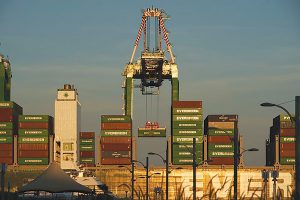During the pandemic, shortages of workers plagued the logistics chain, except for one link. Trucking companies, railroads, warehouse operators— all struggled to find enough employees to keep goods moving. Maritime ports were the exception.
Once workers join the International Longshore and Warehouse Union, they don’t easily walk away from the job. There was no Great Resignation or quiet quitting at the West Coast docks. The pay and benefits rank among the best in the nation for work that doesn’t require education beyond a high school diploma. A journeyman mechanic on the third shift makes $88.77 an hour, and the hourly wage for a crane operator on the second shift is $67.52. In addition to about 15,000 unionized port workers, about 7,000 so-called casuals show up in case they’re needed.
They try to accumulate hours and impress union bosses in a bid to be hired on eventually as full members of the ILWU.
The West Coast port union has real power because it can shut down the nation’s supply chain and has wielded this advantage to increase wages and lock in job security for its members. Looking out for workers is laudable, of course, but the union is also throwing up obstacles that could improve efficiency at the ports. It has dug in its heels to stop port operators from introducing automated equipment, a chief sticking point to renewing a labor contract that expired in July.
The ILWU is now free to call a strike and shut down 29 Pacific Coast ports. There’s little concern this will happen before the midterm elections, but a strike afterward is definitely in the cards. There have been port disruptions in the past over labor negotiations; the last one began in 2014 and ended after the Obama administration intervened.
The union needs to drop its resistance to automation and instead manage the introduction of technology while ensuring that its workers will be operating it. The ports at Los Angeles and Long Beach will fall behind competing ones in Canada and on the US East Coast if stymied from adopting machinery to improve efficiency.
This doesn’t mean that all the ports would suddenly purchase automated cranes and become ghost towns for workers — far from it. Automating ports is difficult and expensive. None have been fully automated, and it’s just not possible or even economically feasible now. The job of lashing down the containers on the ships with metal rods, for example, isn’t going anywhere. The world has 53 container terminals with automation, and most were built that way from the start, according to the International Transport Forum, an intergovernmental organization with 63 member countries. About a third are in Asia, 28% are in Europe and only 11% in the United States.
Only ports with large and steady volume are good candidates for automated equipment. That includes the ports on San Pedro Bay in Los Angeles and Long Beach. The terminal operators there, which are mostly owned by large foreign maritime shipping companies, are eager to invest in projects that they say make moving maritime containers more productive.
 The Gulf Time Newspaper One of the finest business newspapers in the UAE brought to you by our professional writers and editors.
The Gulf Time Newspaper One of the finest business newspapers in the UAE brought to you by our professional writers and editors.
